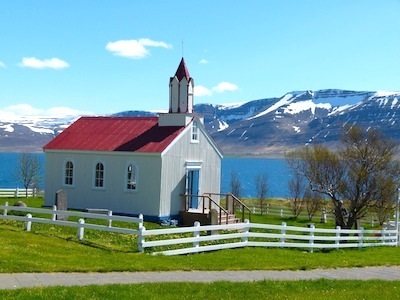Shore Excursion: Visiting birthplace of Iceland’s independence hero
HRAFNSEYRI, Iceland – rafnseyrirafne Iceland gained its independence from Danish rule on June 17, 1944. No shots were fired. No one was killed.
Who was the man Icelanders say was mainly responsible for this bloodless revolution? Iceland’s independence was obtained by the hard work of many but it is attributed mostly to the tireless efforts of a man named Jón Sigurðsson.
Born June 17, 1811, Jón is credited with stirring a great national awakening in Iceland. He became a national hero for fighting for Icelandic independence. For an interesting shore excursion, we headed to Hrafnseyri in the Westfjords to visit the birthplace of Jón Sigurðsson. I’m told this can be a very isolated place in the winter when roadways are blocked with snow. But during the brief summer months when the site is open, the views are glorious. A wonderful museum was opened here on June 17, 2011, to celebrate the 200th birthday of the man often called Iceland’s “president.”
“The June 17th birthday of Jón Sigurðsson is celebrated in Iceland as our Independence Day,” said museum guide Valdimar Halldórsson, adding that Jón’s image is on the 500-Icelandic paper bill.
Gaining independence
By 1874, Iceland had been under harsh Danish rule for hundreds of years and was almost bankrupt during the time of the Trade Monopoly. The Icelandic people wanted their freedom. Through his diplomatic skills and his belief that the pen is mightier than the sword, Jón helped achieve it for them.
By the way, I am told in Iceland it is proper to refer to a person by the given name in writing– Jón. The last name is patronymic, not a family name. It reflects the father or mother of the child and not the historic family lineage.
For example, if Jón Einarsson has a son named Tom, the boy’s last name will be not Einarsson like his father’s. Instead, it will be Jónsson, meaning he is the son of Jón. If Jón Einarsson has a daughter and names her Jane, her last name would not be Einarsson but Jónsdóttir – the daughter of Jón.
A prolific writer about Icelandic history, politics and economics, Jón published a magazine declaring arguments for Iceland’s right to independence and hammered away at Danish leaders. His motto was “Aldrei ad vikja” (Never let down). It worked. The right to free trade was established in 1854 and 20 years later, a constitution was drawn up making Iceland self governing in home affairs.
Sadly, Jón didn’t live to see Iceland become a sovereign state under the Danish crown on December 1, 1918, nor to see Iceland gain full independence from Denmark and declare itself a republic on June 17, 1944. But he had laid the important framework for this to happen and Icelanders have never forgotten.
“He is our hero,” Valdimar said. “He is Iceland’s pride, sword and shield.”
Much to see at new museum site
The modern museum has an interesting exhibit on Jón’s life, Iceland’s history and other fascinating Icelanders, including Hrafn Sveinbjarnarson for whom the farm was named. An influential man in the 12th–13th century, he lived here and was probably the first trained doctor in Iceland.
“He operated to take a diseased kidney out of a man,” Valdimar said. “That was a new way of thinking, to go inside a human body for treatment.”
Records are sparse about the good doctor, Valdimar added, “but we believe he learned that at medical school in Salermo, Italy.”
Although Hrafn was a hospitable and generous man who never refused anyone a medical service at no charge, the good doctor met a tragic end. He was beheaded by a warring chieftain on March 4, 1213.
“The doctor is probably buried in that graveyard,” Valdimar said, gesturing to a lovely wooden chapel surrounded by an ancient cemetery. “The graveyard here is from the beginning of Christianity.”
Jón is not buried in the cemetery. After his death on Dec. 7, 1879, he was given a state funeral in Reykjavík.
The museum site also has a gable-roofed turf house, similar to the one where Jón was born. Refreshments can be bought in the house and visitors can wander through the various rooms to see what life was like in Jón’s times.
Story and Photo by Jackie Sheckler Finch















View Recent Comments